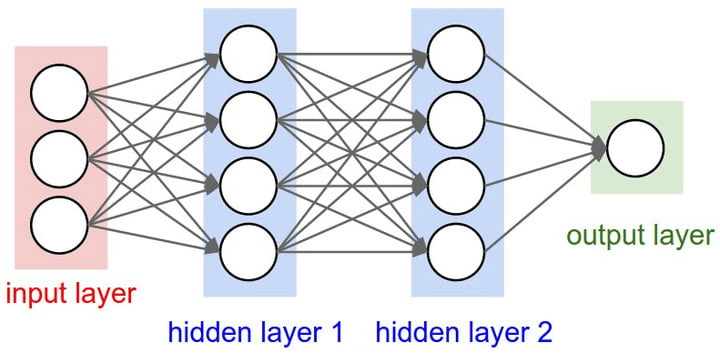People believe Artificial Intelligence (AI) is dominating the Fourth Industrial Revolution. Lately, it has garnered attention from companies across the world. It powers some of the fascinating and sophisticated applications today like voice assistants, drones, driverless cars, and face-recognizing software. AI, and its important subset, machine learning are penetrating every industrial sector, including banking and finance, healthcare, education, manufacturing, and aviation.
According to Grand View Research, the global artificial intelligence market size was worth $39.9 billion in 2019 and is projected to reach $733.7 billion by 2027, growing at a Compound Annual Growth Rate (CAGR) of 42.2% from 2020 to 2027. Out of the total revenue generated in 2019, it was deep learning that led the market, accounting for over 39% share. Deep learning, an important aspect of machine learning, dominated the overall growth owing to its complicated data-driven applications, which include text and speech recognition. Machine learning and deep learning contribute to cognitive applications like clustering, visualization, filtering, hypothesis generation, tagging, etc., and facilitate the development of intelligent solutions.
With such prominence of deep learning, it makes sense to know more about it. This article gives you an introduction to deep learning and why professionals prefer taking a Deep learning course to enhance their skills in this domain.
An Introduction to Deep Learning
The above section used three terms in particular which may seem confusing – artificial intelligence, machine learning, and deep learning. Let us begin by understanding AI-first. Artificial Intelligence encompasses all the efforts taken to teach a machine to mimic the working of a human brain. Generally, AI covers the practices that give machines human-like intelligence to reason, think, learn, and perform various manual tasks.
Now, machine learning can be thought of as an approach that is used to achieve artificial intelligence. It refers to the techniques and use of algorithms to identify trends from the data and build AI applications. Just like human behavior, machine learning enables a machine to ‘learn’ from experience (feedback) and make predictions about unknown data. For this, a lot of data is given as input to the machines to train them. Various ML algorithms are used to solve different problems like linear regression, Naive Bayes, K-nearest neighbor, support vector machines, and classification.
Finally, deep learning is a subset of machine learning that allows machines to deal with more complex problems. The algorithms used in deep learning use complex multi-layered neural networks that are inspired by the biological neural network of the human brain. Also known as artificial neural networks, they analyze data with a logical structure that is quite similar to how a human brain draws conclusions. Deep learning models are quite sophisticated and can make their own predictions entirely without human interference.
Here is how an artificial neural network looks:

As you can see, there is an input layer in the beginning that takes input data. The input layer connects to the hidden layers through weights. The weights connect to the different nodes present in the hidden layers. These nodes process the inputs given to them, and it continues to the next hidden layer. In the diagram, only two hidden layers are shown (for convenience), but an actual neural network consists of many hidden layers.
These hidden layers act as efficient tools to identify patterns and trends that are too complex for a human being to help a machine learn it. They perform various kinds of mathematical computations on the input data and transform it into a format that the output layer can accept. The output layer finally returns the outcome that corresponds to the prediction of the response variable. In a neural network, the performance of the model is affected by certain parameters and hyperparameters. The output of neural networks depends hugely on such parameters. Weights, learning rate, bias, and batch size are some of such parameters.
Where is Deep Learning Used?
Deep learning can be used for various interesting applications like handwritten character recognition, signature classification, speech recognition, self-driving cars, and voice-activated assistants. With the availability of massive amounts of computational power, machines are now able to recognize objects and translate speech in real-time. A fascinating application is Google Lens which converts the text in front of the smartphone camera into any language you want it.
Many deep learning applications are already creating an impact in our daily lives. Predicting earthquakes, detection of brain cancer, stock market analysis, energy market price forecasting, data-driven predictive advertising are some of the deep learning applications garnering a lot of attention.
In the years to come, deep learning is going to witness increased adoption, and people would see more sophisticated products that leverage this technology. Deep learning specialists are in high demand these days. Google, Amazon, IBM, Oracle, Microsoft, Twitter, and Facebook are some of the top companies that seek deep learning engineers. So, the time is ripe for learning more about deep learning and starting a career in this promising field.
Professionals rely on online deep learning courses to learn everything from scratch. Due to their busy schedule, individuals find it easier to take eLearning courses which can be completed at a convenient pace. The major benefit is it can be accessed anytime, anywhere, without the need to go to any physical location. Moreover, they get guidance from industry experts and earn a sharable certification at the end.
